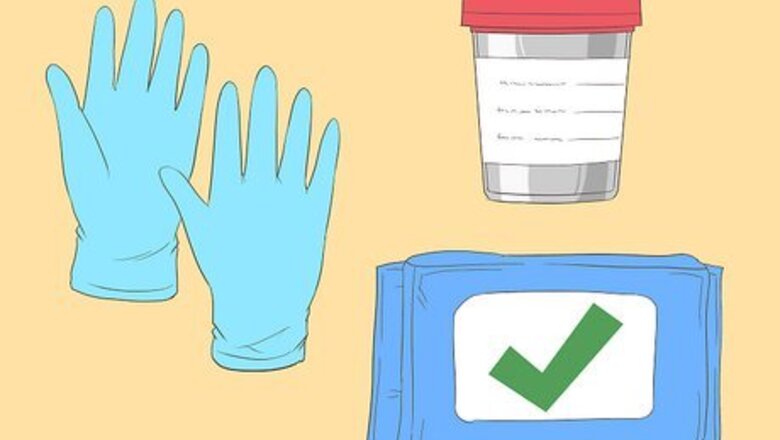
views
X
Research source
so collecting their urine and looking for bacteria is important. For older children who can understand they need to pee into a cup, the "clean-catch" method is best. For infants who are too young to understand or cooperate, the "bag specimen" method must be used.[2]
X
Research source
Getting an uncontaminated urine sample from a young girl is more challenging because of her anatomy — you must be extra diligent with cleaning and collecting.[3]
X
Trustworthy Source
PubMed Central
Journal archive from the U.S. National Institutes of Health
Go to source
Contaminated urine samples result in false-positive test results,[4]
X
Research source
which often lead to needless use of antibiotics or more invasive medical testing.
Using the Clean-Catch Method

Collect your supplies. If your female child is old enough to pee while sitting on a toilet and can understand your instructions, then try the clean-catch method of collecting a urine sample. You'll need a sanitized specimen cup to collect the urine, some antibacterial wet wipes, a roll of paper towels and a pair of latex or vinyl medical gloves. Your doctor will likely supply you with a specimen cup and medical gloves so you can collect a urine sample at home. Your doctor may also supply you with special wipes for this purpose. The wet wipes are to thoroughly clean your daughter's genitalia so no bacteria on her skin gets into her urine sample. Paper towels are a good idea to keep on hand to wipe up any urine spills and to dry your hands after washing.

Prepare your daughter. Explain to your daughter what you need from her and why, then ask her to tell you when she feels the need to urinate. Once she needs to go, quickly undress her from the waist down, including removing her panties so they don't get in the way. She can still wear socks and a top to keep warm, as long as the top doesn't interfere with cleaning her vagina or collecting a urine sample. Place your daughter on the toilet, with legs spread far apart and prepare to clean her. If you are able, before attempting to collect a urine sample, give your daughter a bath earlier in the day and wash her genitalia with soap and water. It's best not to rely on wet wipes entirely for cleaning. To trigger your daughter to pee, give her lots of water or milk to drink after her bath. So you're not in a big rush to prepare, ask your daughter to tell you when she first feels the slight need to pee, not when the feeling has become urgent.

Wash your hands thoroughly. Once your daughter is undressed and on the toilet, wash your hands thoroughly with warm water and soap so you don't transfer any bacteria onto your daughter. Dry your hands completely with paper towels, use them as a barrier to open the wet wipe container, then toss the towels into the garbage. Be sure to lather between your fingers, underneath your fingernails, and all the way up past your wrists for at least 20 seconds. In addition to soap and water, consider also cleaning your hands with some alcohol-based sanitizer. Avoid touching anything, particularly your mouth or face, after you sanitize your hands and are about to clean your daughter.
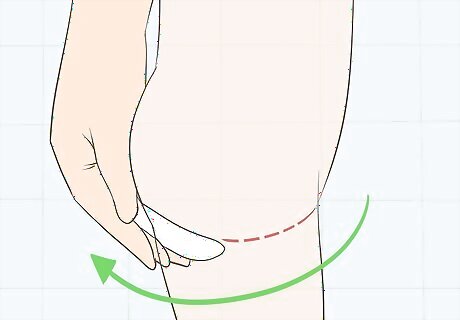
Clean your daughter's genitalia. Once your daughter is straddling the toilet with legs spread far apart, ask her to lean back so you have better access to her vagina. Using your index and middle finger of one hand, gently separate her labia (the skin folds around where the urine comes out). With the other hand, take a wet wipe and clean directly over the meatus (the pee hole), using one stroke from top to bottom, then discard the wipe. The meatus is just above the opening to the vagina. Take another antibacterial wet wipe and use it to clean within the skin folds off to one side of the meatus, then a third wipe to clean the skin folds on the opposite side. Use only one stroke, going from top to bottom (or towards the anus), with the wet wipes before discarding them. Don't clean in a circular motion. Don't wipe from bottom to top because you may introduce bacteria from the anus into the vaginal area.

Put on gloves and open the collection cup. Once you've carefully cleaned your daughter's genitalia and disposed of the antibacterial wet wipes, wash and dry your hands again and put on the medical gloves. The gloves will prevent any transfer of bacteria to your daughter and they'll protect your hands from getting peed on. Urine is not harmful to your hands, but some parents might think it's gross or get bothered by it. Once your gloves are on, take the top of the sterilized plastic collection cup off and hold it near your daughter's urethra (pee hole). When opening the collection cup, don't contaminate it by touching the insides of the lid or container with your fingers, even if your think they are clean. Place the cup upside down on a clean paper towel while you're waiting to collect the urine sample. If you don't have a sanitized collection cup from your doctor, boil a small glass jar and lid for about 10 minutes. Allow the jar and lid to air dry in a clean place before using it.
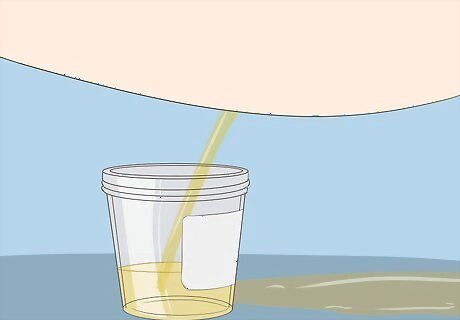
Collect the urine sample. While holding your daughter's labia apart with one hand and holding the specimen cup in the other near her urethra, tell her she can release her urine. After she has peed a small amount, position the cup directly under the stream and be careful not to touch her with the cup. Take the cup away when it's about 1/3 full (don't let it spill over) and then let her finish peeing normally if she has to. If your daughter has any difficulty starting her stream, try turning on the water faucet to trigger her. Collecting urine midstream (after a second or two) is recommended because the first ounce or two help flush out any debris (dead cells, protein). Urine doesn't keep very long at room temperature, so put it in the fridge immediately after collecting it.
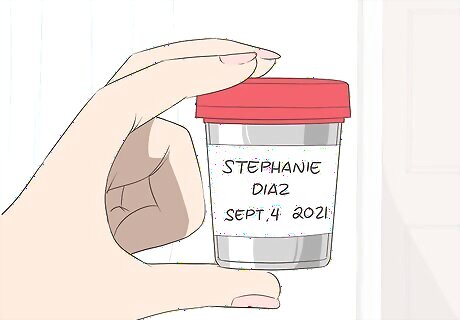
Put the lid on the cup and label it. Once you've collected the urine sample, place the cup on a paper towel and screw or snap the plastic lid back on tightly without touching the inside of it. Once the lid is secured, take off your gloves and wash the outside of the cup and your hands again, making sure to dry it with a clean paper towel. After the collection cup is dried, write the date, time and your daughter's name on it with a felt marker. If you're collecting urine from your daughter at the doctor's office, then simply give the sample to the nurse or assistant. If you're at home and unable to go directly to the doctor's office, then refrigerate the sample until you can go — don't wait more than 24 hours, or else any bacteria in the sample will proliferate.
Using the Bag Specimen Method
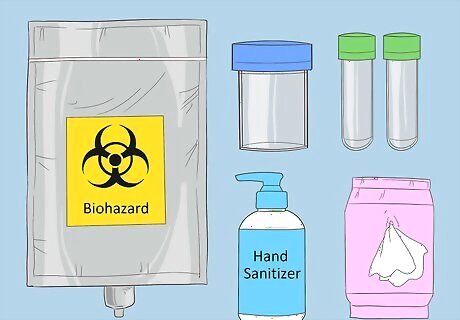
Collect your supplies. If your female infant is not old enough to pee while sitting on a toilet and can't understand your instructions, then your best bet is to try the bag specimen method of collecting a urine sample. You'll need a special bag to collect the urine and a sanitized specimen cup (both provided by your doctor), as well as some antibacterial wet wipes or special wipes provided by your doctor and a bottle of hand sanitizer. The special collection bag is a plastic bag with a sticky strip on one end, which is made to fit over your infant's genital area, but underneath their diaper. Urine infections are very difficult to diagnose from urine samples in a bag specimen because of the high risk of contamination. However, it can give your doctor a general idea of the genitourinary health of your child.

Prepare your infant daughter. The collection bag is meant to fit over the labia of your daughter, so she needs her clothing and diaper removed to gain access. She can still wear socks and a top to keep warm, as long as the top doesn't interfere with cleaning her vagina and attaching the collection bag. Place her on a changing table and remove her diaper and throw it away. Clean her as best you can if she's soiled herself. Don't use any baby powder after cleaning her, as it may contaminate the urine sample. In the morning, before trying to collect urine, give your daughter a bath and wash her genitalia thoroughly with soap and water. After the bath, avoid overfeeding her before trying to collect a sample so she doesn't poop in her diaper and increase the chances of bacterial contamination. Giving her lots of liquids after her bath will trigger her to pee sooner.
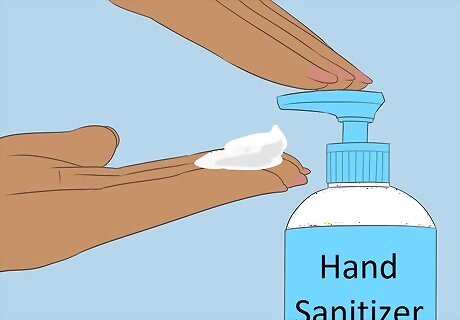
Wash your hands with sanitizer. Once your daughter is undressed and on the changing table, lather your hands thoroughly with alcohol-based sanitizer and let them air dry while keeping an eye on your infant to make sure she doesn't roll off the table. Once she's on the changing table, it's too risky to run to the bathroom and wash your hands with warm water and soap, so sanitizer is best. Remember to lather underneath your fingernails and all the way up past your wrists with the sanitizer. Apply a second squirt of sanitizer to your hands to be on the safe side, but don't use it on your infant's genitalia — it might irritate the skin, so stick with the antibacterial wet wipes.
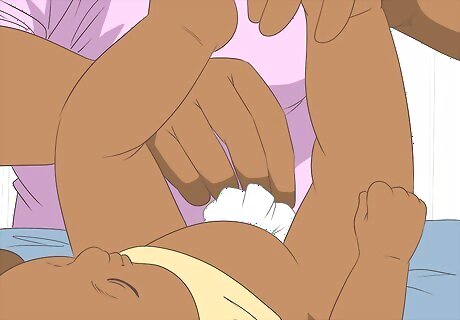
Clean your infant's genitalia.After you've sanitized your hands, it's time to clean your daughter's labia and the area around the opening of her urethra (meatus) more thoroughly. The meatus is just above the opening to the vagina. Using your index and middle finger of one hand, gently separate her labia. With your other hand, take an antibacterial wet wipe and clean directly over the meatus, using one stroke from top to bottom. Take a couple more wet wipes and use them to clean within the skin folds of the labia near the urethra — first one side and then the other. Feel free to wear vinyl or latex sanitary gloves at this stage, although it's not crucial. Wipe in only one direction, going from top to bottom (from the vagina to the anus), with the wipes before discarding them. Don't clean in a circular motion. Wiping up from the anus may introduce bacteria into your infant's vaginal area.
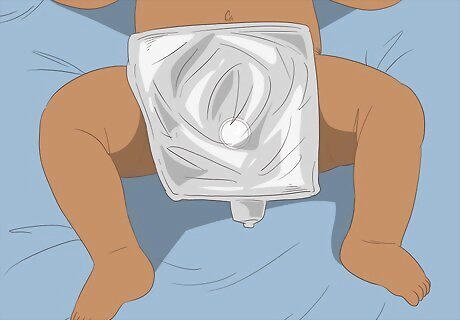
Place the collection bag on your infant. Open the small plastic collection bag and place it on your daughter. The bag is meant to be placed over the two folds of labia skin on either side of her vagina. Make sure the sticky strip adheres to her surrounding skin, then wrap her up in a fresh diaper and let her crawl or walk around. To prevent a mess, always place a clean diaper over the collection bag so there's no leaking. Check your daughter every hour to see if she's peed. You'll need to open the diaper and then re-close it if she hasn't An active infant can cause the bag to move around and become unstuck, so it may take multiple tries with multiple bags to collect a sample.
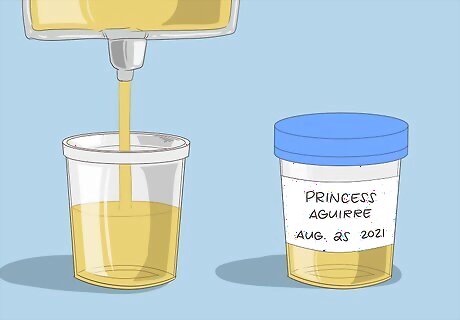
Empty the bag into the sterile cup. Once you've noticed your daughter has peed, wash your hands again and then carefully remove the small bag without spilling too much of the urine sample. You may want to put on gloves for this part as some of the urine may spill onto your hands. Transfer the urine from the bag to the sterilized collection cup and then throw away the bag. Fill about 1/2 to 1/3 of the cup only. Tightly fasten the cups lid and then wash any urine off it and let it air dry. Once dry, write the date, time and your daughter's name on it with a felt marker and store it in the fridge until you have a doctor's appointment. Prior to removing the collection bag, it's a good idea to unscrew the the lid from the sterile collection cup and place it upside down on a clean paper towel. Do not touch the inside of the sterile cup or lid when transferring the urine from the collection bag.



















Comments
0 comment